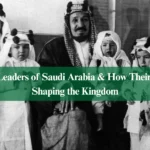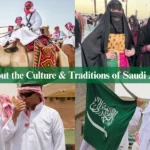Saudi Arabia’s economy is one of the most significant in the Arabian Peninsula. The country is majorly driven by its vast oil reserves. In fact, it is also the leading member of the G20 and the Organization of the Petroleum Exporting Countries (OPEC). For the past few decades, Saudi Arabia has focused on strengthening the other aspects of the economy as well. Besides, the country is also looking forward to several future developments, including Vision 2030. Let’s talk about the components of the Saudi economy and its diversification efforts. Here we go…
The Economic Sectors of Saudi Arabia |
||
|---|---|---|
| Sector | Key Initiatives | Goals |
| Oil and Gas | Saudi Aramco investments, production efficiency | Maintain global leadership in oil exports |
| Tourism | NEOM, Red Sea Project | Increase tourism’s GDP contribution from 3% to 10% |
| Entertainment | Riyadh Season, theme parks | Enhance local and international entertainment |
| Technology | Innovation hubs, support for startups | Foster a digital economy and attract tech talent |
| Manufacturing | National Industrial Development Program | Boost local production and reduce imports |
| Trade | Development of logistics infrastructure, trade agreements | Diversify trade portfolio and enhance global competitiveness |
| Women in Workforce | Education and vocational training programs | Increase female labor force participation |
| Economic Cities | King Abdullah Economic City, NEOM, Jazan Economic City | Diversify the economy and create job opportunities |
Key Components of the Saudi Economy
The economy of Saudi Arabia is now multifaceted, with several key components driving its growth and stability. While the oil and gas sector remains the main player, significant efforts are underway to diversify into tourism, entertainment, agriculture, and manufacturing. Here is an overview of all the vital sectors impacting the economy:
-
Oil and Gas Sector
Saudi Arabia is the world’s largest oil exporter, possessing approximately 17% of the world’s proven oil reserves. The oil and gas sector accounts for about 55% of the country’s revenue and 30% of its GDP. The state-owned company, Saudi Aramco, is the backbone of this sector, contributing significantly to the national economy.
Did You Know?
Saudi Arabia’s oil reserves are estimated at around 266 billion barrels, making it the second-largest holder of oil reserves in the world, after Venezuela.
Saudi Aramco’s operations extend beyond oil extraction; it is involved in refining, distribution, and marketing. The company has made substantial investments in technology and infrastructure to enhance production efficiency and reduce costs.
-
Agriculture and Fisheries
While oil dominates the economy, agriculture and fisheries also play a role. The government has invested in agricultural projects to achieve food security, focusing on crops like wheat, dates, and fruits. The fishing industry is also being developed to enhance local food production, with initiatives aimed at sustainable fishing practices.
-
Manufacturing and Industry
Saudi Arabia is working to boost its manufacturing sector, particularly in petrochemicals, plastics, and metals. The establishment of industrial cities and economic zones aims to attract foreign investment and create job opportunities for Saudi citizens. The National Industrial Development and Logistics Program (NIDLP) is a key component of Vision 2030. It focuses on enhancing the industrial sector’s contribution to the economy.
-
Trade
Trade plays a crucial role in the economy of Saudi Arabia. Not just in the present, it also plays a role in the history of KSA. The Kingdom’s strategic location serves as a gateway between Europe, Asia, and Africa, enhancing its position in global trade networks. In recent years, Saudi Arabia has diversified its trade portfolio, focusing on non-oil exports and fostering partnerships through initiatives like Vision 2030. This approach aims to reduce dependency on oil revenues, stimulate economic growth, and attract foreign investment across various sectors.
Important:
“Saudi Arabia is the 19th largest exporter and the 20th largest import market in the world.” – The Embassy of the Kingdom of Saudi Arabia
The Kingdom’s trade policies are evolving to support sustainable economic development and enhance competitiveness. By investing in infrastructure, such as ports and logistics, Saudi Arabia aims to streamline trade processes and improve efficiency.
Vision 2030: Economic Diversification
In response to fluctuating oil prices and the need for economic sustainability, Saudi Arabia launched Vision 2030 in 2016. This ambitious plan aims to diversify the economy by reducing its dependence on oil and fostering growth in other sectors such as:
-
Tourism
The Saudi government is making substantial investments in the tourism sector, aiming to transform the Kingdom into a global travel destination. Major projects like NEOM and the Red Sea Project are designed to attract international visitors by offering luxurious resorts, adventure activities, and cultural experiences. You should know that the Saudi government aims to attract 100 million visitors annually by 2030, with plans to develop historical and cultural sites. With a target to increase tourism’s contribution to GDP from 3% to 10% by 2030, the Kingdom aims to strengthen the infrastructure, promote heritage sites, and host international events.
-
Entertainment
The entertainment sector in Saudi Arabia is experiencing rapid growth, driven by a cultural shift and government support. Events like the Riyadh Season have become popular, featuring concerts, sports competitions, and cultural festivals that draw both local and international audiences. The Kingdom is also investing in the development of theme parks, cinemas, and entertainment complexes, aiming to create a vibrant leisure landscape that enhances the quality of life for residents and attracts tourists.
Did You Know?
In December 2024, Saudi Arabia was to host the FIFA World Cup in 2034.
-
Technology and Innovation
Saudi Arabia is actively fostering a culture of technology and innovation, particularly in urban centers like Riyadh and Jeddah. The government is promoting tech startups and establishing innovation hubs to stimulate economic growth and job creation. Investments are being directed toward emerging fields such as artificial intelligence, cybersecurity, and digital transformation. By encouraging collaboration between private and public sectors, the Kingdom aims to position itself as a leader in the digital economy and attract global tech talent.
The Economic Cities of Saudi Arabia
Saudi Arabia is developing several economic cities to diversify its economy and create job opportunities. Notable projects include King Abdullah Economic City (KAEC), which focuses on logistics and manufacturing near Jeddah; NEOM, a futuristic mega-city integrating smart technologies and sustainable living; and Jazan Economic City, aimed at boosting local industries like food processing and logistics. Additionally, Ras Al Khair Industrial City targets maritime industries. Apart from this, the Riyadh Integrated Special Logistics Zone (RISLZ) focuses on enhancing trade efficiency, supporting logistics and distribution sectors, all contributing to the Kingdom’s Vision 2030 goals.
Economic Challenges
Despite its wealth and resources, Saudi Arabia faces several economic challenges. These include youth unemployment, reliance on oil revenues, and environmental concerns. Addressing these issues is crucial for sustainable growth. Here is a comprehensive overview:
- Youth Unemployment: With a significant portion of the population under 30, job creation is essential to address youth unemployment. The government is implementing programs to enhance vocational training and entrepreneurship.
- Economic Dependence on Oil: The volatility of oil prices poses risks to economic stability. The Kingdom is working to create a more resilient economy by diversifying its revenue sources.
- Environmental Concerns: The reliance on fossil fuels raises questions about sustainability and environmental impact. The government is exploring renewable energy sources, including solar and wind power, to reduce its carbon footprint.
Women in Workforce
Saudi Arabia is making significant strides in increasing female participation in the workforce as part of its Vision 2030 initiative. The government has implemented various reforms aimed at empowering women. These include lifting restrictions on driving as well as promoting gender equality in employment opportunities. Programs focused on education and vocational training are designed to equip women with the skills needed for diverse industries. Additionally, initiatives encourage women to pursue careers in sectors traditionally dominated by men, such as technology and engineering. As a result, the female labor force participation rate is steadily rising, contributing to economic growth in a more inclusive way.
Conclusion
The economy of Saudi Arabia is undergoing a significant transformation as it seeks to diversify beyond oil dependency. With initiatives like Vision 2030, the Kingdom is positioning itself for a sustainable future. After all, it now focuses on sectors such as tourism, technology, and manufacturing. As the country navigates its economic challenges, it remains a pivotal player in the global economy.
By understanding the dynamics of the Saudi economy, investors and businesses can better navigate opportunities in this growing market. The Kingdom’s commitment to diversification and innovation promises a positive future economic development.




